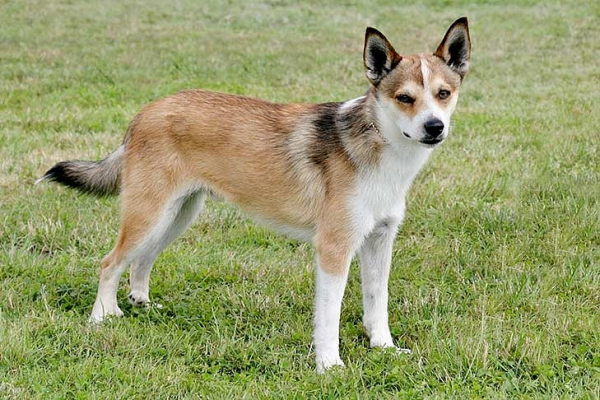Podzim láká k dogtrekkingu
Úporná vedra pominula a lesy hrají všemi barvami. To je ideální čas na dogtrekking. Udělejte něco pro svoje i pejskovo zdraví a vyrazte do přírody v zápřahu!
These special dogs were bred and raised specifically for hunting of puffins and guillemots (water birds). For this reason, they have several very specific and for their purpose very practical physical deviations. For example, they have extremely flexible neck so they can turn their head to their back. They can also close their auditory canals so water or clay couldn’t enter it. Also, they have more fingers on their paws as the only breed – they have 6 fingers and 8 finger pads. They used all of them to stick to rocky reefs when hunting puffins. Thanks to loose ligaments in shoulder joints they can spread their legs so much that they lean on ground with their chest.


These special dogs were bred and raised specifically for hunting of puffins and guillemots (water birds). For this reason, they have several very specific and for their purpose very practical physical deviations. For example, they have extremely flexible neck so they can turn their head to their back. They can also close their auditory canals so water or clay couldn’t enter it. Also, they have more fingers on their paws as the only breed – they have 6 fingers and 8 finger pads. They used all of them to stick to rocky reefs when hunting puffins. Thanks to loose ligaments in shoulder joints they can spread their legs so much that they lean on ground with their chest.
All these physical abnormalities helped these dogs hunt birds in their burrows. Today, they are only used socially. Breeders greatly appreciate their energetic temperament, vigilance and protective tendencies and also nice and adaptable nature. They love loud barking so even though they like strangers, the strangers (especially neighbours :)) don’t have to like them. Yet, this is a great family dog, sociable and cuddly. They come back on call and assist their masters with everything. They don’t tend to attack except for bird nests which is understandable considering their history.
When upbringing a norwegian lundehund, the best for them is kind treatment. They also need enough activity in order not to get bored and disobey. They are intelligent, very active and vulpine. But they can also be quite stubborn and headstrong. Even though it is a resistant breed that can live outdoors all year, these dogs like to laze about at home.
This breed is really small. They weigh around 5 to 7 kilograms and aren’t usually taller than 38 centimetres. Have you ever been lucky and seen a norwegian lundehund? Its physical skills are worth seeing in person, you can hardly imagine a dog doing split.


Úporná vedra pominula a lesy hrají všemi barvami. To je ideální čas na dogtrekking. Udělejte něco pro svoje i pejskovo zdraví a vyrazte do přírody v zápřahu!


Rozhodli jste se sobě anebo dětem pořídit mazlíka a volba padla na křečka? Tápete však jakého vybrat? Který druh je nejaktivnější, a který zase nejmazlivější? Pro koho se jaký vůbec hodí?


Chlorid sodný je velmi důležitou součástí psí stravy, stejně jako té naší. Udržuje v chodu několik důležitých procesů v těle. Nadbytek soli ale může mít na psa velmi negativní účinek hned v několika směrech.


American Curl má velmi nápadný zjev díky svým dozadu natočeným uším. Mimo Spojených států, kde toto plemeno vzniklo, je ještě celkem vzácností. Už i u nás ho ale najdete. Je to velmi společenská kočka, které doma nic neunikne.


V listopadu se koná překvapivě hodně akcí pro psy. Ať už jde o závody nebo výstavy. Zvláště v Praze je pak z čeho vybírat. Podívejte se, kam můžete se svým pejskem před zimou ještě vyrazit.


Ačkoli jde o malého psíka, teriéra v sobě prostě nezapře. Je to oddaný pes napumpovaný energií, který má v sobě stále pudy lovce krys.


Vědci došli k závěru, že majitelé koček jsou méně depresivní, úzkostní nebo uzavření. Vylučuje se to tedy s představou stereotypu “divných kočičích dam”, které si chlupaté parťáky pořizují kvůli osamělosti.


U psů začíná stáří mezi 5. a 8. rokem života. Vstupují tak do fáze, kdy se jejich potřeby mění, ať už jde o péči, pohyb nebo stravu. Aby si i nadále udrželi svou vitalitu a radost ze života, je potřeba to respektovat.


Jistě mi dáte za pravdu, že kočky se v pohádkách objevují docela často. Dnes se podíváme na českou klasiku. Pojďte si zavzpomínat a připomenout si dětství.


O nově vzniklém registru psích dárců krve už jsem psala. Pojďme se tedy podívat, jak samotné darování krve probíhá, kdo ho může podstoupit a proč je tak důležité. Třeba někoho z vás přesvědčím, aby se do registru se svým parťákem zapsal.


Je podzim a kočky se převlékají do svých zimních kabátů. My tuto skutečnost pociťujeme hlavně při uklízení domácnosti. Těch chomáčů chlupů je najednou víc, jsou větší a oblečení odchlupujeme dvakrát tak dlouho. Jak nad kočičími chlupy vyhrát nejen v...


Posvátná kočka z Barmy má nápadný exotický výraz. Asi o žádném jiném plemeni se nevede tolik hypotéz o původu, jako o těchto klidných a rozumných kočkách.